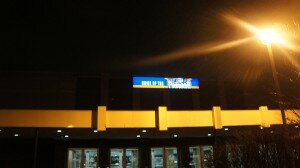
Dort Federal Credit Union Center
With Rolf Nilsen and his staff suspended from hockey operations, what should happen in Flint? With the stigma attached to Rolf Nilsen and junior hockey, Nilsen would be wise to sell the team. Seriously, why own a team in a league that suspended you? To his credit, he did not lock out the team.
Meanwhile, in a former OHL market, Brampton, their ECHL team who was to replace the recently departed Brampton Battalion, is hemorrhaging money at an alarming rate.
According to HockeyDatabase, the Beast are averaging an attendance around 2500 over 3 seasons. The team has lost $4 million since their inception. For the 2016-2017 season, Beast management asked for and received a bailout of 1.5 million dollars. The team also bemoaned to Brampton city council that rental fees for the Powerade Centre is $300,000 per season. The Beast asked City council to look at buying the Powerade Centre from Realstar Group, a private real estate investment and management company.
This is where Flint comes in. Nilsen’s group, IMS US Inc., invested approximately $2-3 million on arena updated prior to the 2015-16 season.
With a team losing $1.5 million a year, and a possible 4,000-seat arena looking for a tenant, it could be a match. Nilsen has stated his dream of owning a hockey team and with his Firebirds almost slipping from his hands, could the Brampton Beast fulfill his dream of owning a hockey team as well as finding a tenant for his arena?
Here are my reasons why:
- Flint has hosted a professional hockey team from 1969-1990, and from 1991-2010. For the last 10 seasons of existence (2000/01 – 2009/10) Flint averaged around 2400 fans. The following 5 seasons, the NAHL Michigan Warriors averaged roughly 960. This year, the team has averaged roughly around 3, 000. With the attendance booming, having a mid-level professional team would tie Flint back to its professional hockey roots. Promotions such as the following reinforce Flint as a professional hockey town.
GAME DAY! The Firebirds host tonight at 7:30PM on Bob Perani Bobblehead Night & Scout Night!
— Flint Firebirds (@FlintFirebirds)
- As with the reputation of being a dangerous city, legal guardians are reluctant to have their 16/17 year old child/-ren playing in Flint. With the minimum age for the ECHL at 20, the team would not have to worry about parents/guardians preventing players from playing in Flint.
- An owner like Nilsen, who has already invested approx. $3 million USD in arena upgrades would provide the ECHL with a stable financial owner. Perhaps Flint could be a franchise who actually stays in the league longer than 5 seasons.
- The Firebirds brand can do a reverse “Hamilton Bulldogs”. Where the Flint Firebirds would become an ECHL team and keep all the branding, including:
Tweet Your Seat at tonight's game for a chance to win a Firebirds Prize Pack!
— Flint Firebirds (@FlintFirebirds)
The second issue is where does the Flint Firebirds go?
Possible Canadian Destinations:
1. Belleville
Capacity: 3,257
Pros: Strong fan base (minimum 70%+ capacity for last 10 years as Bulls)
Cons: The arena is rather small and not up to OHL standards. The city does not seem interested in renovating or building a new area that lead to the loss of the Belleville Bulls in 2015.
2. Brampton (2017-2018)
Capacity: 5,000
Pros: New-ish arena.
Cons: as earlier stated, a private company owns the arena. Another con, in a solely hockey sense, is the changing demographics of Brampton.
3. Waterloo
Capacity: 4,132
Pros: Arena is relatively new (1994). Possible luxury boxes can be added on the running track if it becomes a long-term stay.
Cons: Kitchener Rangers Chief operating officer and team governor Steve Bienkowski will not waive the 80 km rights.
4. Cornwall
Capacity: 5,000
Pros: Former OHL rink
Cons: As Marchhockey said: “For nostalgia’s sake, I love the Complex. It is a great venue for hockey but let’s be honest with ourselves. It would never work for a modern team in this day and age.”
5. Stratford
Capacity: 2.828
Pros: Strong Hockey town (The GOJHL Cullitons draw on average 1,200 fans a game)
Cons: The Allman is 91 years old. Small market (Perth County’s Population is around 77,000). Parking is terrible, especially with the Festival Theatre.
6. Woodstock
Capacity: 2,000 seating, 500 standing
Pros: Expandable (In my opinion) arena where possible luxury boxes can be added if the arena was expanded
Cons: Small market (Oxford County’s Population is around 106,000)
7. Brantford
Capacity: 2981
Pros: Former OHL facility.
Cons: Downtown location is “sketchy” and next door to the Casino (unless you’re a gambler, then it’s a pro). The town has been hit hard economically and its proximate location to Hamilton.
8. Chatham
Capacity: 2,412
Pros: It is still standing
Cons: No seats, maximum capacity is 3000. Small market (Chatham-Kent County’s Population is around 110,000)
US Locations:
Pros: 3,400 Seat Rink with no major tenant
Despite Fraser’s small population (14,000), the county (Macomb County) in which Fraser is located has a population of 835,000. Fraser is also located in Metro Detroit
Cons: Part of Metro Detroit
Capacity: 20,804
Pros: Large Capacity
Cons: Large Capacity. The arena is owned by Palace Sports and Entertainment so the Firebirds would have, in theory, to be bought by them. The failure of the Detroit Vipers could leave a deep impact that could Palace Sports and Entertainment off. Scheduling would be brutal with the Pistons and other tentants/events.
3. Buffalo, NY
Capacity: 19,070
Pros: Large Capacity. Metro Buffalo’s population is 1.13 Million
Cons: Like Auburn Hills, if you get 4,000 fans, the building is only at 20% capacity. Scheduling would be brutal with the Sabres and other tenants/events.
Capacity: 2,100
Pros: It would give the OHL’s foot in the door in Western New York, without the gigantic First Niagara Arena to fill and schedule around.
Cons: Approximately 1 ½ hours from Buffalo would scare off possible Buffalo fans. Small market (Chautauqua County’s Population is around 77,000)
Inasmuch as I would like to see Ontario gain another OHL team, it would make the most sense to me for the team to locate to Fraser, Michigan. The OHL maintains its presence in Michigan; flees the reputation of Flint; and builds upon Macomb County native NHLers: David Booth; Danny DeKeyser; Matt Hunwick; Chad LaRose and previous NHLers: Derian & Kevin Hatcher; and Doug Weight. Despite the low attendance for the Metro Jets of NA3HL (average 293 for 2015-16), I’m sure the presence of an OHL team with the growing influx of American players into the OHL will draw new fans to the OHL and strengthen the OHL’s presence in Michigan.

